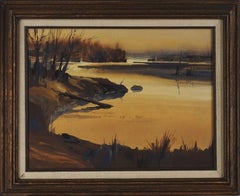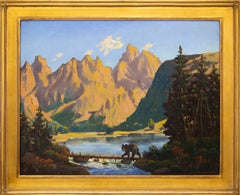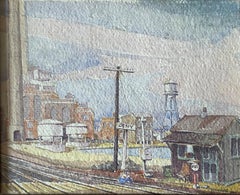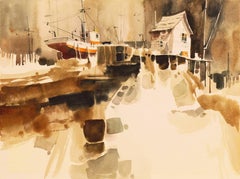Ritchie A. Benson Art
American, 1941-1996
Ritchie A. Benson grew up in Los Angeles and first studied at the Los Angeles Art Center. A member of the American Watercolor Society and the California Watercolor Society, Benson has exhibited nationally since the 1960s and is the recipient of numerous medals, prizes and juried awards. He is represented by the Challis Gallery of Laguna Beach and the Art Association. Ritchie Benson is known for his delicate, modernist watercolor views of the coast of California and Washington state.
to
1
1
Overall Width
to
Overall Height
to
1
1
1
1
1
1
1
1
1
1
1
7,820
5,167
2,504
1,501
1
1
Artist: Ritchie A. Benson
"Misty Lagoon", Monochrome 1970's Lanscape Watercolor
By Ritchie A. Benson
Located in Soquel, CA
A gorgeous American Impressionist watercolor painting of a serene lagoon in a brown/orange monochrome palette by Ritchie Allen Benson (American, 1914-1991). Titled "Misty Lagoon." Presented in a wood frame. Signed "R. A. Benson" lower left. Framed size: 25"H x 31"W. Image: 23.5"W x 17.5"H.
Ritchie A. Benson grew up in the Los Angeles area during the World War 11 era. By the late 1950s, he was studying watercolor painting and by the 1960s was exhibiting on a national level. He spent a great deal of time painting along the California coast and was most interested in producing works which pictured boats and harbor scenes.
His watercolors were sold through the Challis Gallery in Laguna Beach and through art association exhibition sales. Although he continued to paint occasionally in Southern California, most of Bensen's later works were done in Mendocino, California, or farther north in Washington state where he spent a lot of time painting on the beaches...
Category
Mid-20th Century American Impressionist Ritchie A. Benson Art
Materials
Paper, Watercolor, Board
Related Items
Little Bear, 1950s Framed Traditional Western Mountain Landscape Painting
By Harold Vincent Skene
Located in Denver, CO
Little Bear is a traditional Landscape painting by Harold Skene (1883-1978). The mid 20th century painting depicts a brown or black bear crossing on a log...
Category
Mid-20th Century American Impressionist Ritchie A. Benson Art
Materials
Oil, Board
H 29.5 in W 35.5 in D 0.75 in
"Train Station, " Max Kuehne, Industrial City Scene, American Impressionism
By Max Kuehne
Located in New York, NY
Max Kuehne (1880 - 1968)
Train Station, circa 1910
Watercolor on paper
8 1/4 x 10 1/4 inches
Signed lower right
Provenance:
Private Collection, Illinois
Max Kuehne was born in Halle, Germany on November 7, 1880. During his adolescence the family immigrated to America and settled in Flushing, New York. As a young man, Max was active in rowing events, bicycle racing, swimming and sailing. After experimenting with various occupations, Kuehne decided to study art, which led him to William Merritt Chase's famous school in New York; he was trained by Chase himself, then by Kenneth Hayes Miller. Chase was at the peak of his career, and his portraits were especially in demand. Kuehne would have profited from Chase's invaluable lessons in technique, as well as his inspirational personality. Miller, only four years older than Kuehne, was another of the many artists to benefit from Chase's teachings. Even though Miller still would have been under the spell of Chase upon Kuehne's arrival, he was already experimenting with an aestheticism that went beyond Chase's realism and virtuosity of the brush. Later Miller developed a style dependent upon volumetric figures that recall Italian Renaissance prototypes.
Kuehne moved from Miller to Robert Henri in 1909. Rockwell Kent, who also studied under Chase, Miller, and Henri, expressed what he felt were their respective contributions: "As Chase had taught us to use our eyes, and Henri to enlist our hearts, Miller called on us to use our heads." (Rockwell Kent, It's Me O Lord: The Autobiography of Rockwell Kent. New York: Dodd, Mead and Co., 1955, p. 83). Henri prompted Kuehne to search out the unvarnished realities of urban living; a notable portion of Henri's stylistic formula was incorporated into his work.
Having received such a thorough foundation in art, Kuehne spent a year in Europe's major art museums to study techniques of the old masters. His son Richard named Ernest Lawson as one of Max Kuehne's European traveling companions. In 1911 Kuehne moved to New York where he maintained a studio and painted everyday scenes around him, using the rather Manet-like, dark palette of Henri.
A trip to Gloucester during the following summer engendered a brighter palette. In the words of Gallatin (1924, p. 60), during that summer Kuehne "executed some of his most successful pictures, paintings full of sunlight . . . revealing the fact that he was becoming a colorist of considerable distinction." Kuehne was away in England the year of the Armory Show (1913), where he worked on powerful, painterly seascapes on the rocky shores of Cornwall. Possibly inspired by Henri - who had discovered Madrid in 1900 then took classes there in 1906, 1908 and 1912 - Kuehne visited Spain in 1914; in all, he would spend three years there, maintaining a studio in Granada. He developed his own impressionism and a greater simplicity while in Spain, under the influence of the brilliant Mediterranean light. George Bellows convinced Kuehne to spend the summer of 1919 in Rockport, Maine (near Camden). The influence of Bellows was more than casual; he would have intensified Kuehne's commitment to paint life "in the raw" around him.
After another brief trip to Spain in 1920, Kuehne went to the other Rockport (Cape Ann, Massachusetts) where he was accepted as a member of the vigorous art colony, spearheaded by Aldro T. Hibbard. Rockport's picturesque ambiance fulfilled the needs of an artist-sailor: as a writer in the Gloucester Daily Times explained, "Max Kuehne came to Rockport to paint, but he stayed to sail." The 1920s was a boom decade for Cape Ann, as it was for the rest of the nation. Kuehne's studio in Rockport was formerly occupied by Jonas Lie.
Kuehne spent the summer of 1923 in Paris, where in July, André Breton started a brawl as the curtain went up on a play by his rival Tristan Tzara; the event signified the demise of the Dada movement. Kuehne could not relate to this avant-garde art but was apparently influenced by more traditional painters — the Fauves, Nabis, and painters such as Bonnard. Gallatin perceived a looser handling and more brilliant color in the pictures Kuehne brought back to the States in the fall. In 1926, Kuehne won the First Honorable Mention at the Carnegie Institute, and he re-exhibited there, for example, in 1937 (Before the Wind). Besides painting, Kuehne did sculpture, decorative screens, and furniture work with carved and gilded molding. In addition, he designed and carved his own frames, and John Taylor Adams encouraged Kuehne to execute etchings. Through his talents in all these media he was able to survive the Depression, and during the 1940s and 1950s these activities almost eclipsed his easel painting. In later years, Kuehne's landscapes and still-lifes show the influence of Cézanne and Bonnard, and his style changed radically.
Max Kuehne died in 1968. He exhibited his work at the National Academy of Design, the Art Institute of Chicago, the Carnegie Institute in Pittsburgh, the Memorial Art Gallery of the University of Rochester, and in various New York City galleries. Kuehne's works are in the following public collections: the Detroit Institute of Arts (Marine Headland), the Whitney Museum (Diamond Hill...
Category
1910s American Impressionist Ritchie A. Benson Art
Materials
Paper, Watercolor
"Canal at Indian Mound Road" RARE Ben Fenske Gouache work on paper black & white
By Ben Fenske
Located in Sag Harbor, NY
Painted during the 2015 Winter Equestrian Festival in Wellington, Florida. A black and white depiction of a canal, is barely recognizable, due to Fenske's wild brushstrokes and lack...
Category
21st Century and Contemporary American Impressionist Ritchie A. Benson Art
Materials
Paper, Gouache
"Forest Landscape" John F. Carlson, circa 1925 American Impressionist Landscape
By John F. Carlson
Located in New York, NY
John F. Carlson
Forest Landscape, circa 1925
Signed lower right
Watercolor on paper
Sight 21 x 24 1/2 inches
The native Sweden John Fabian Carlson became a household name in New Yo...
Category
1920s American Impressionist Ritchie A. Benson Art
Materials
Paper, Watercolor
"Beach House Scene" American Impressionism Coastal Landscape Watercolor on Paper
By Martha Walter
Located in New York, NY
This piece is a playful depiction of a beach house scene of the ocean, sand, and view of a house with its garden with joyful colors and precious deta...
Category
Early 20th Century American Impressionist Ritchie A. Benson Art
Materials
Paper, Watercolor
H 20.75 in W 22.5 in D 1.5 in
"Monhegan Island, Maine, " Edward Dufner, American Impressionism Landscape View
By Edward Dufner
Located in New York, NY
Edward Dufner (1872 - 1957)
Monhegan Island, Maine
Watercolor on paper
Sight 16 x 20 inches
Signed lower right
With a long-time career as an art teacher and painter of both 'light' and 'dark', Edward Dufner was one of the first students of the Buffalo Fine Arts Academy to earn an Albright Scholarship to study painting in New York. In Buffalo, he had exchanged odd job work for drawing lessons from architect Charles Sumner. He also earned money as an illustrator of a German-language newspaper, and in 1890 took lessons from George Bridgman at the Buffalo Fine Arts Academy.
In 1893, using his scholarship, Dufner moved to Manhattan and enrolled at the Art Students League where he studied with Henry Siddons Mowbray, figure painter and muralist. He also did illustration work for Life, Harper's and Scribner's magazines.
Five years later, in 1898, Dufner went to Paris where he studied at the Academy Julian with Jean-Paul Laurens and privately with James McNeill Whistler. Verification of this relationship, which has been debated by art scholars, comes from researcher Nancy Turk who located at the Smithsonian Institution two 1927 interviews given by Dufner. Turk wrote that Dufner "talks in detail about Whistler, about how he prepared his canvasas and about numerous pieces he painted. . . A great read, the interview puts to bed" the ongoing confusion about whether or not he studied with Whistler.
During his time in France, Dufner summered in the south at Le Pouleu with artists Richard Emil Miller...
Category
Early 20th Century American Impressionist Ritchie A. Benson Art
Materials
Paper, Watercolor
Gloucester
By Guy Carleton Wiggins
Located in Milford, NH
A fine impressionist harbor scene in Gloucester, Massachusetts by American artist Guy Carleton Wiggins (1883-1962). Wiggins was born in Brooklyn, New York, and had a long and success...
Category
Early 20th Century American Impressionist Ritchie A. Benson Art
Materials
Oil, Board
'Pacific Surf, San Diego', Worcester Art Museum School, San Bernadino College
By Richard Gabriel Chase
Located in Santa Cruz, CA
Signed lower left, 'Richard Gabriel Chase' (American, 1919-2007) and painted circa 1960.
Born in Massachusetts, Chase first studied at the Worcester Art Museum School, later earning his degree from Massachusetts College of Art. He subsequently studied privately with Ernest Major...
Category
1960s American Impressionist Ritchie A. Benson Art
Materials
Gouache, Board, Graphite
H 22 in W 27.88 in D 0.13 in
New York Skyline the West Side with Hudson River - Vintage New York
By Frank S. Hermann
Located in Miami, FL
Rooftop view of the upper West Side Manhattan as it looked in the 1930s. There is a rough indication of a billboard and a glimpse of the Hudson River. The cluster of buildings depic...
Category
1930s American Impressionist Ritchie A. Benson Art
Materials
Oil, Gouache, Board
Band Concert
By Walter Farndon
Located in Milford, NH
An impressionist painting of a band concert in the gazebo at night done by English / American artist Walter Farndon (1876-1964). Farndon was born in...
Category
Early 20th Century American Impressionist Ritchie A. Benson Art
Materials
Oil, Board
Untitled - Impressionist Plein Air Landscape Painting
By Stuart Shils
Located in East Quogue, NY
Impressionist style plein-air landscape painting of trees and buildings by Stuart Shils. Oil on paper mounted on rag board.
Image size: 12.75 x 17.75 inches. Frame size: 20 x 25 x ...
Category
1980s American Impressionist Ritchie A. Benson Art
Materials
Paper, Oil, Board
20th Century Oil WPA Style Oil Painting Urban Landscape c.1950
Located in San Francisco, CA
20th Century Oil WPA Style Oil Painting
Oil on board. Approximately 20" wide x 16" high.
The frame is approximately 24" wide x 20" high.
S...
Category
Mid-20th Century American Impressionist Ritchie A. Benson Art
Materials
Oil, Board
Previously Available Items
'Fishing Boat in Dry Dock', AWS, CWS Artist, California Tonalist view
By Ritchie A. Benson
Located in Santa Cruz, CA
Signed lower left, 'R.A. Benson' for Ritchie A. Benson (American, 1941-1996) and painted circa 1955.
Ritchie Benson grew up in Los Angeles and first studied there at the Los Angeles Art Center. A member of the American Watercolor Society and the California Watercolor Society, Benson has exhibited nationally since the 1960s and is the recipient of numerous medals prizes and juried awards. He is represented by the Challis Gallery of Laguna Beach and the Art Association. Ritchie Benson is known for his delicate, modernist watercolor views of the coast of California and Washington state and we are pleased to offer a characteristic early work by this noted California watercolorist...
Category
1950s Modern Ritchie A. Benson Art
Materials
Illustration Board, Watercolor
Ritchie A. Benson art for sale on 1stDibs.
Find a wide variety of authentic Ritchie A. Benson art available for sale on 1stDibs. You can also browse by medium to find art by Ritchie A. Benson in board, paint, watercolor and more. Much of the original work by this artist or collective was created during the 20th century and is mostly associated with the modern style. Not every interior allows for large Ritchie A. Benson art, so small editions measuring 10 inches across are available. Customers who are interested in this artist might also find the work of Eve Nethercott, Greta Allen, and James March Phillips. Ritchie A. Benson art prices can differ depending upon medium, time period and other attributes. On 1stDibs, the price for these items starts at $925 and tops out at $1,720, while the average work can sell for $1,323.
Artists Similar to Ritchie A. Benson
Questions About Ritchie A. Benson Art
- How do I date a Benson watch?1 Answer1stDibs ExpertNovember 22, 2024To date a JW Benson watch, check the markings on its back. Most timepieces will feature British standard metal hallmarks as well as maker's marks. You can use online reference guides to determine the rough age of your watch based on these markings. Alternatively, you can consult a certified appraiser or experienced antique dealer. On 1stDibs, explore a selection of JW Benson watches.
- 1stDibs ExpertJanuary 27, 2025The famous photographer Benson is Harry Benson. Always in the right place at the right time, Benson has used his camera to give the world a glimpse into events rocking the globe. His black-and-white and color photographs include shots of celebrities, politicians, royalty, political upheavals and social revolutions. In 1989, Benson photographed the student protests in Tiananmen Square and the fall of the Berlin Wall. He was with President Clinton on his historic visit to Kosovo in 1999 and captured New York City in the aftermath of the September 11, 2001, terrorist attacks. Benson has also photographed every president since Eisenhower and took numerous images of Queen Elizabeth II. Shop a variety of Harry Benson photography on 1stDibs.
- 1stDibs ExpertNovember 22, 2024The history of JW Benson watches begins in 1855, when watchmaker J. W. Benson established a workshop in London. Within a decade, he was well-known throughout the city for his finely crafted watches and clocks. Following the founder's death in 1878, his sons, Alfred and Arthur, took over the company. Under their leadership, JW Benson unveiled a watch strap resistant to moisture and dust. It also received royal commendations from Queen Victoria, the Prince of Wales and the kings of both Denmark and Siam. During World War I, JW Benson contributed to the war effort by producing trench watches for soldiers. The business thrived during the following years, but its factory was bombed during World War II. JW Benson never resumed production of watches after the war but continued to run a shop on Bond Street, where it sold jewelry and timepieces crafted by other makers. This store closed in the 1980s when it was bought out by Mappin & Webb. On 1stDibs, explore a collection of JW Benson watches.
- Are JW Benson watches valuable?1 Answer1stDibs ExpertNovember 22, 2024Yes, some JW Benson watches are valuable. Select models made during the first two decades of the 20th century, particularly its trench watches that date back to World War I, may sell for thousands. However, other models are worth considerably less, though they may still have some value, as many JW Benson watches were silver and can therefore be sold for scrap. The potential selling price of a JW Benson timepiece depends on its style, age, materials, condition and other factors. A certified appraiser or experienced antique dealer can provide an expert valuation for any timepiece you own. On 1stDibs, explore a variety of JW Benson watches.



